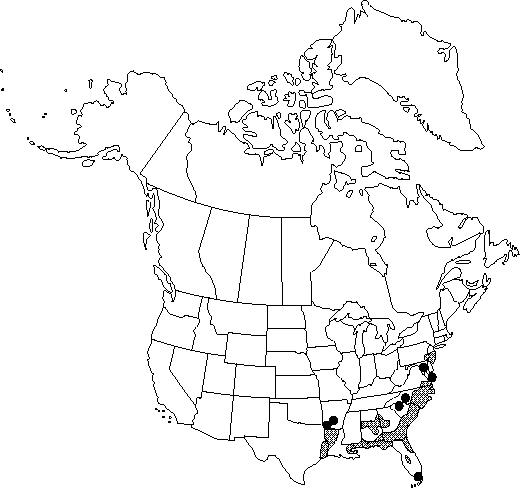Myrica heterophylla
Alsogr. Amer., 9. 1838.
Shrubs or small trees, evergreen or tardily deciduous, often forming rhizomatous colonies of much-branched specimens, to 3 m. Branchlets appearing black, glabrous to densely pilose; glands sparse or dense, yellow-orange. Leaf blade aromatic when crushed, oblanceolate to elliptic, occasionally obovate, 3-12.4(-14.2) × 1-5.2 cm, sometimes membranous, more often leathery, base cuneate to attenuate, margins entire or serrate distal to middle, apex rounded to acute, apiculate; surfaces abaxially pilose (especially on major veins) or glabrate, densely glandular, adaxially pilose or glabrous, lacking glands or very sparsely glandular; glands yellow. Inflorescences: staminate 0.5-1.8 cm; pistillate 0.3-1.1 cm. Flowers unisexual, staminate and pistillate on different plants. Staminate flowers: bract of flower shorter than staminal column, margins opaque, ciliate, especially at apex and laterally, abaxially glabrous or with few glands; stamens 3-5(-7). Pistillate flowers: bracteoles persistent in fruit, 4, not accrescent or adnate to fruit wall, abaxially pilose, usually along midrib, lacking glands; ovary glabrous or sparsely glandular, not pubescent. Fruits globose-ellipsoid, 3-4.5 mm; fruit wall glabrous or sparsely glandular, obscured by enlarged protuberances (± glandular) and thin to thick coat of gray to white wax.
Phenology: Flowering spring–early summer, fruiting summer–fall.
Habitat: Bogs, stream, pond and lake margins, moist regions of mixed deciduous forests, pine flatlands near pitcher-plant bogs, swamps
Elevation: 0-250 m
Distribution

Ala., Ark., D.C., Fla., Ga., La., Md., Miss., N.J., N.C., Pa., S.C., Tex., Va.
Discussion
I have not seen any specimens of Myrica heterophylla from Delaware although it is listed in other floras as occurring there.
To distinguish between Myrica heterophylla and M. pensylvanica in the vegetative condition is difficult at best. Although M. heterophylla tends to have larger, persistent leaves (versus smaller, deciduous ones in M. pensylvanica), the difference breaks down, especially in the northern portion of the range of M. heterophylla. Male specimens provide little help in resolving this problem because the inflorescences are virtually identical. Female specimens are most useful (essential?) for definitive delimitation because the ovary and young fruit (wall and protuberances) of M. pensylvanica are pubescent in contrast to the glabrous or sparsely glandular fruits of M. heterophylla. Whether these differences are sufficient to warrant the recognition of distinct species is yet to be satisfactorily resolved. W. M. Houghton (1988) attempted to settle this matter, eventually recognizing two subspecies in M. pensylvanica, but he did not examine floral features in his analysis. Again, I have taken the conservative route, leaving the question largely unanswered.
Selected References
None.